Ministry of Science & Technology
National Science Day (28 February)
Posted On: 28 FEB 2024 3:04PM
“India has a rich legacy in science, technology and innovation. Our scientists have done path-breaking research. Our tech industry is at the forefront of solving global problems. But India wants to do more. We look at the past with pride but want an even better future.”
National Science Day is celebrated every year on 28th February to commemorate the discovery of the ‘Raman Effect’ made by the eminent physicist Sir C.V. Raman while working in the laboratory of the Indian Association for the Cultivation of Science, Kolkata. For this discovery, he was awarded the Nobel Prize in 1930. On National Science Day, theme-based science communication activities are carried out all over the country.[1]
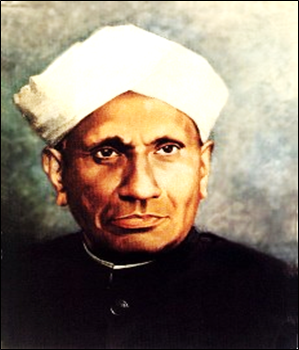
In 1986, the National Council for Science and Technology Communication (NCSTC) requested the Government of India to designate February 28 as National Science Day, which was accepted by the Government of India. The first National Science Day was celebrated on February 28, 1987.[2]
The Raman Effect is a phenomenon in spectroscopy. It is a change in the wavelength of light that occurs when a light beam is deflected by molecules. When a beam of light traverses a dust-free, transparent sample of a chemical compound, a small fraction of the light emerges in directions other than those of the incident (incoming) beam. Most of this scattered light is of an unchanged wavelength. A small part, however, has wavelengths different from those of the incident light; its presence is a result of the Raman Effect.
Objectives
The basic objective of the observation of National Science Day is to spread the message of the importance of science and its application among the people. It is celebrated as one of the main science festivals in India every year with the following objectives:
- To widely spread a message about the significance of scientific applications in the daily lives of people
- To display all the activities, efforts, and achievements in the field of science for the welfare of human beings
- To discuss all the issues and implement new technologies for the development of science
- To encourage the people as well as popularize science and technology
Theme for National Science Day 2024
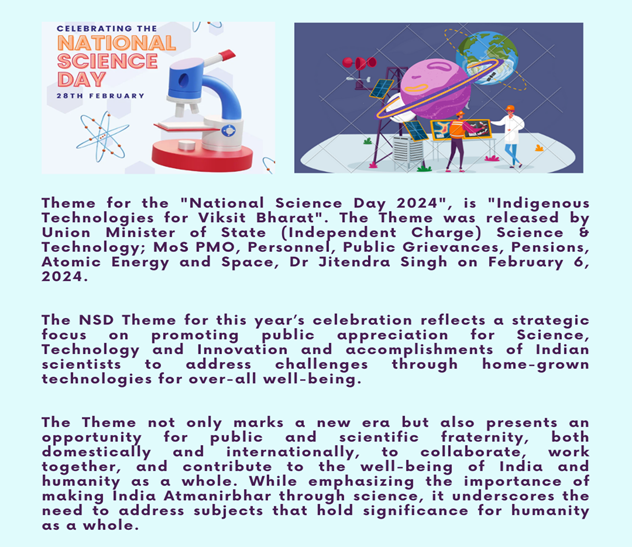
Scientific Achievements of India
Here are a few major achievements of India in the field of Science and Technology in the recent years:
Mission Chandrayaan-3: On August 23, 2023, India created history with the successful landing of Chandrayaan 3 on the surface of the Moon in the South Pole area. Over the next few days, several experiments, such as measurement of near-surface plasma content, presence of mineral elements, temperature profile of the lunar topsoil, etc. were conducted by the onboard payloads, marking a major feat in lunar exploration. To know more about Mission Chandrayaan-3, click here.
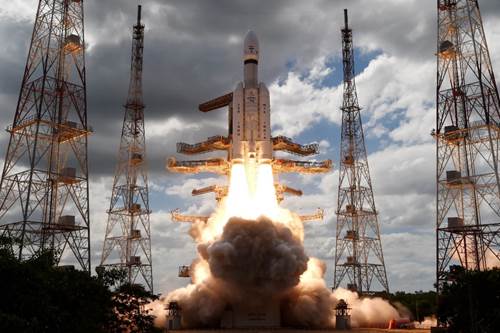
Mission Gaganyaan: The Gaganyaan Mission is India’s first human space flight program for which extensive preparations are underway at various ISRO centers. The date of the mission launch has not been finalized yet. However, Prime Minister Narendra Modi on 27 February 2024 visited Vikram Sarabhai Space Center (VSSC) at Thiruvananthapuram, Kerala, and reviewed the progress of the Mission and bestowed ‘astronaut wings’ to the four astronaut-designates -- Group Captain Prashanth Balakrishnan Nair, Group Captain Ajit Krishnan, Group Captain Angad Pratap and Wing Commander Shubhanshu Shukla.[3]
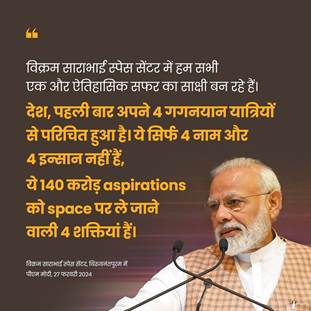
Navigation with Indian Constellation (NavIC): To meet the positioning, navigation, and timing requirements of the nation, ISRO has established a regional navigation satellite system called Navigation with Indian Constellation (NavIC). NavIC was erstwhile known as the Indian Regional Navigation Satellite System (IRNSS). NavIC is designed with a constellation of 7 satellites and a network of ground stations operating 24 x 7. Three satellites of the constellation are placed in geostationary orbit, at 32.5°E, 83°E, and 129.5°E respectively, and four satellites are placed in inclined geosynchronous orbit with an equatorial crossing of 55°E and 111.75°E respectively, with an inclination of 29° (two satellites in each plane). The ground network consists of a control center, precise timing facility, range and integrity monitoring stations, two-way ranging stations, etc.[4]
GenomeIndia
The GenomeIndia endeavor is complex, yet much needed to understand our nation’s genetic makeup. The project aims to identify genetic variations through whole genome sequencing of 10,000 representative individuals across India in the first phase of the study.
GenomeIndia is a consortium of 20 national institutes, which exemplifies the significance of collaborative, nation-wide, mission-oriented scientific partnerships, and visionary funding by the Department of Biotechnology, Government of India, and is spearheaded by Centre for Brain Research (CBR).
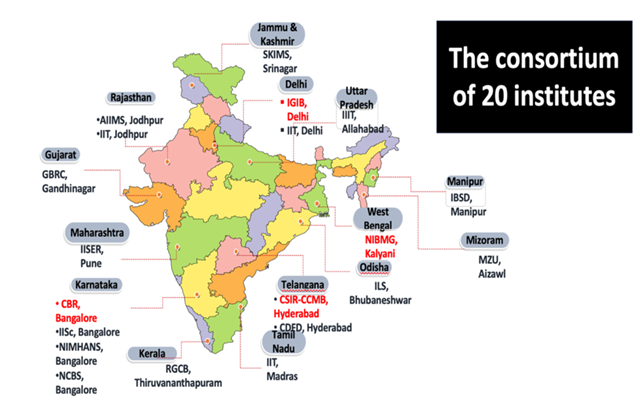
Announcing the GenomeIndia Flagship Programme of 10,000 Genome Sequencing on February 27, 2024, Union Minister of State (Independent Charge) Science & Technology, Dr Jitendra Singh said India's bio-economy has grown 13-fold in the last 10 years from $10 billion in 2014 to over $130 billion in 2024. He added that the Biotechnology Sector has seen rapid growth in the last 10 years and India is now being rated among the top 12 bio-manufacturers in the world.[5]
In the wake of recent scientific achievements, it may be underscored that the rising trajectory of India over the past decade is being witnessed globally. India retained the 40th position in the Global Innovation Index among the top innovative economies globally per the Global Innovation Index (GII) 2023. As per the World Intellectual Property Organization (WIPO) Report 2022, India is ranked at 7th position in terms of Resident Patent Filing activity in the world.
Also, India has improved its ranking to 60th position (2023) from 79th position (2019) as per the Network Readiness Index (NRI) 2023 report. NRI is one of the leading global indices on the application and impact of information and communication technology (ICT) in 134 economies worldwide.

Some important initiatives taken by the Government of India to promote science & technology in the country are mentioned below:
Anusandhan National Research Foundation
The Anusandhan National Research Foundation (ANRF) has been established with Anusandhan National Research Foundation (ANRF) Act 2023. The ANRF aims to seed, grow, and promote research and development (R&D) and foster a culture of research and innovation throughout India’s universities, colleges, research institutions, and R&D laboratories. ANRF will act as an apex body to provide high-level strategic direction of scientific research in the country as per recommendations of the National Education Policy 2020 (NEP). ANRF will forge collaborations among the industry, academia, government departments, and research institutions, and create an interface mechanism for participation and contribution of industries and State governments in addition to the scientific and line ministries.
National Quantum Mission
A “National Quantum Mission (NQM)” has been launched at a total cost of Rs. 6003.65 crore for eight years to seed, nurture, and scale up scientific and industrial R&D and create a vibrant & innovative ecosystem in Quantum Technology (QT). This will accelerate QT led economic growth, nurture the ecosystem in the country and make India one of the leading nations in the development of Quantum Technologies & Applications (QTA). The next generation transformative technologies that will receive a push under this Mission includes Quantum Computing, Quantum Communication, Quantum Sensing and Metrology, Quantum Materials and Devices. Implementation of the NQM is in progress.
National Geospatial Policy 2022
Demonstrating commitment towards inclusive development, the Government is implementing the National Geospatial Policy 2022 (NGP) and has substantially expanded the access and usage of spatial data, improving citizens services rapidly and increasing its reach to the remotest corners of the country. In order to implement the NGP which was launched in 2022, the Department of Science and Technology (DST) consolidated the governance framework to liberalise geospatial data access. DST is continuously strengthening Geospatial Data Infrastructure and enterprise development.[6]
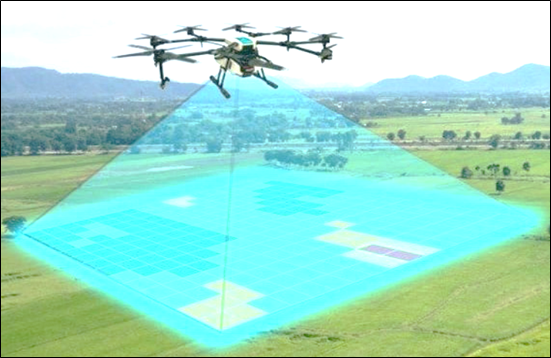
The Policy emphasizes on Atmanirbhar Bharat by empowering local companies to generate and utilize their own Geospatial data; encourages open standards, open data and platforms; focuses on easy accessibility of Geospatial data through National Geospatial Data Registry and Unified Geospatial Interface; supports innovation, incubation of ideas and start-up initiatives in the Geospatial sector; and encourages capacity building.
Atal Innovation Mission (AIM)
Atal Innovation Mission (AIM) is Government of India’s flagship initiative to create and promote a culture of innovation and entrepreneurship across the length and breadth of our country. AIM’s objective is to develop new programmes and policies for fostering innovation in different sectors of the economy, provide platforms and collaboration opportunities for different stakeholders, and create an umbrella structure to oversee the innovation & entrepreneurship ecosystem of the country.
With a vision to ‘Cultivate one Million Children in India as Neoteric Innovators’, AIM is establishing Atal Tinkering Labs (ATLs) in schools across India. An ATL is a workspace where young minds can give shape to their ideas through hands-on do-it-yourself mode; and learn innovation skills. Young children get a chance to work with tools and equipment to understand the concepts of STEM (Science, Technology, Engineering and Math). ATL contains educational and learning ‘Do It Yourself’ (DIY) kits and equipment on science, electronics, robotics, open-source microcontroller boards, sensors and 3D printers and computers.
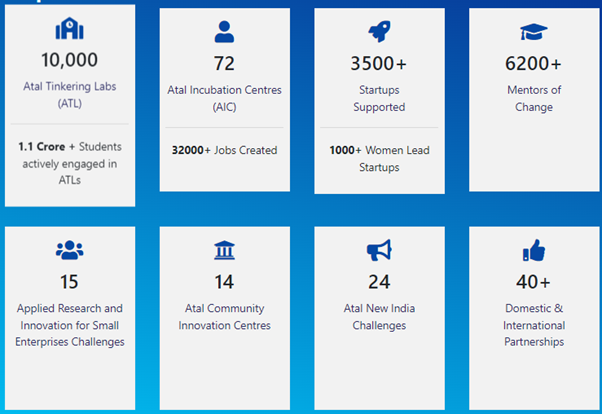
So far, 10,000 ATLs have been established across the country, with 75 lakh students actively engaged. Under the AIM, 72 Atal Incubation Centres have created over 32,000 jobs and supported more than 3,500 Startups of which over 1,000 are led by women.
Innovation in Science Pursuit for Inspired Research (INSPIRE)
The INSPIRE Scheme aims to attract meritorious youth to study basic and natural sciences at the college and university level and to pursue research careers in both basic and applied science areas including engineering, medicine, agriculture and veterinary sciences. The ultimate aim is to expand the R&D base of the country. INSPIRE is a merit-based competitive and Gender-neutral scheme.
Women in Science and Engineering (WISE) - Knowledge Involvement in Research Advancement Through Nurturing (KIRAN)
To promote women in different areas of Science and Technology for gender parity, five (5) new programmes namely, WISE Fellowship for Ph.D. (WISE-PhD), WISE-Post Doctoral Fellowship (WISE-PDF), WISE Internship in Intellectual Property Rights (WISE-IPR), WISE-SCOPE and WIDUSHI have been launched.
- Under Vigyan Jyoti programme, more than 21,000 girls of Class IX-XII from 250 Districts of 34 States/UTs of the country benefitted through various activities and interventions.
- Under the CURIE (Consolidation of University Research for Innovation and Excellence) Programme, support has been extended to establish state-of-the-art research facilities in 18 Women PG Colleges and 2 Women Universities.
References:
Twitter links:
Click here to download in PDF
******
NR/HP/RK/PK/JA
(Backgrounder ID: 151846)
0